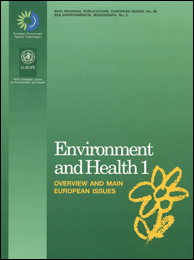All official European Union website addresses are in the europa.eu domain.
See all EU institutions and bodiesAn official website of the European Union | How do you know?
Environmental information systems
Environmental monograph 2/-1
Environment and Health 1 - Overview and Main European Issues
Report (PDF)

Environment and Health 1 - Overview and Main European Issues
Environmental monograph 2/-1
15 Jun 1996
ISBN: 92-890-1332-X
